| |
New European Hypertension Guidelines 2007
|
| |
| |
2007 ESH-ESC Practice Guidelines for the Management of Arterial Hypertension: ESH-ESC Task Force on the Management of Arterial Hypertension
[Guidelines]
OF NOTE to read below:
13. Goals of treatment
14. Lifestyle changes
20. Antihypertensive treatment in special groups (elderly, diabetic, renal dysfunction, cerebrovascular disease, coronary heart disease and heart failure
22. The metabolic syndrome
25. Treatment of associated risk factors
25.1 Lipid lowering agents
25.3 Glycaemic control
Journal of Hypertension:Volume 25(9)September 2007p 1751-1762
Authors/Task Force Members:; Mancia, Giuseppea; Co-Chairperson (Italy); De Backer, Guyb; Co-Chairperson (Belgium); Dominiczak, Annac; (UK); Cifkova, Renatad; (Czech Republic); Fagard, Roberte; (Belgium); Germano, Giuseppef; (Italy); Grassi, Guidog; (Italy); Heagerty, Anthony Mh; (UK); Kjeldsen, Sverre Ei; (Norway); Laurent, Stephanej; (France); Narkiewicz, Krzysztofk; (Poland); Ruilope, Luisl; (Spain); Rynkiewicz, Andrzejm; (Poland); Schmieder, Roland En; (Germany); Boudier, Harry AJ Struijkero; (Netherlands); Zanchetti, Albertop; (Italy)
aUniversity of Milano-Bicocca, Ospedale San Gerardo, Milan, Italy
bDepartment of Public Health, University Hospital, Ghent, Belgium
cUniversity of Glasgow, Glasgow, UK
dInstitute for Clinical Experimental Medicine, Prague, Czech Republic
eCatholic University, Leuven, Belgium
fUniversity La Sapienza, Policlinico Umberto 1, Roma, Italy
gUniversity of Milano-Bicocca, San Gerardo Hospital, Milan, Italy
hUniversity of Manchester, Manchester, UK
iUllevaal University Hospital, Oslo, Norway
jPharmacology Department, Hopital Europeen Georges Pompidou, Paris, France
kDepartment of Hypertension and Diabetology, Medical University of Gdansk, Gdansk, Poland
lHospital 12 de Octubre, Madrid, Spain
mDepartment of Cardiology, Medical University of Gdansk, Gdansk, Poland
nMedizinische Klinik, University Erlangen Nuernberg, Erlangen, Germany
oDept. of Pharmacology, University of Limburg in Maastricht, Maastricht, The Netherlands
pUniversity of Milan, Istituto Auxologico Italiano, Milan, Italy
Special thanks to Jose L. Rodicio Diaz for his contribution.
*Adapted from the 2007 Guidelines for the Management of Arterial Hypertension (J Hypertens 2007; 25:1105-1187).
New European Guidelines on Treatment of Hypertension
News Author: Lisa Nainggolan
CME Author: Laurie Barclay, MD
from Heartwire - a professional news service of WebMD
June 20, 2007 - New guidelines for the management of arterial hypertension have been issued at the European Society of Hypertension (ESH) meeting in Milan, Italy. The recommendations, which were drawn up jointly by task forces from ESH and the European Society of Cardiology, also appear in the Journal of Hypertension.
Co-chair of the task forces, Dr Guy de Backer (University Hospital, Ghent, Belgium) told heartwire the guidelines are essentially an update to 2003 recommendations. The new document is 82 pages long, and lists 825 references, reflecting the vast amount of data published on the subject of hypertension in the past 4 years, he noted.
Asked to pick out highlights for heartwire, de Backer said this was a difficult task, "as there has been no one dramatic change, rather small changes in each area. The most important thing is that this is an update and the numerous references have been critically evaluated. We have kept the general framework and added what we think is most important from the literature."
For the clinician, the main messages can be found in a number of boxes in the paper, which contain position statements, he noted. "All you need to do is look at the position statements in the boxes, and only read the text if you want more detail." The task forces are working hard to produce a pocket version of the new guidelines for release at the ESC meeting in Vienna in September, he added.
No One Choice of First-Line Therapy
The overall goal for blood-pressure reduction has remained the same - to get BP to 140/90 mm Hg in the large majority of people. However, there has been a change in the recommendation for those with comorbidities, de Backer said. For example, there is a new goal of 130/80 mm Hg for people with established cardiovascular disease or diabetes.
In terms of treatment recommendations, he said the new guidelines shy away from recommending one particular class of antihypertensive over another as first-line therapy, rather they emphasize the importance of selecting therapy for each individual, according to any comorbidities they may have.
"We have noted the five important drug classes - diuretics, calcium-channel blockers, ACE-inhibitors, beta-blockers and angiotensin-receptor blockers," he said. But from then on, "if we have to make a choice it should depend on comorbidities."
For example, the best choice of first-line agent for someone with hypertension who also has diabetes is either an ACE inhibitor or an angiotensin-receptor blocker. For those who have suffered a myocardial infarction, the most appropriate drug to use first is a beta-blocker and in the elderly, the first-line drug of choice is generally a calcium-channel blocker to reduce the risk of stroke, he noted.
He added, however, that the emphasis on identification of first-line therapy is often pretty futile, because the majority of patients require multiple blood pressure medications.
Other subjects on which there is more information in the new guidelines include the taking of ambulatory BP measurements, and those performed at home by patients themselves, de Backer noted, adding that the advice for interpreting ambulatory and home BP measurements "is more detailed now."
Extra information can be found on subclinical organ damage, including details about novel markers for renal damage and for arterial stiffness.
J Hypertens. 2007;25:1105-1187.
GUIDELINES from Jnl publication
1. Definition and classification of hypertension
Blood pressure has a unimodal distribution in the population as well as a continuous relationship with CV risk.
For practical reasons the term hypertension is used in daily practice and patients are categorized as shown in Table 1. However the real threshold for defining hypertension must be considered as flexible, being high or low based on the total CV risk of each individual.
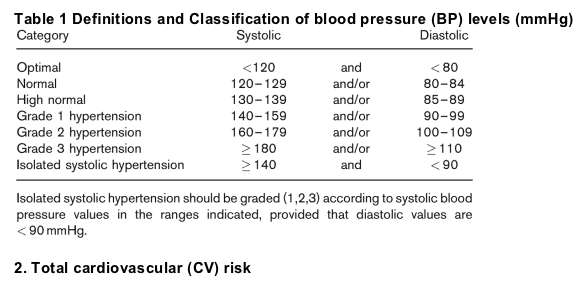
* All patients should be classified not only in relation to the grades of hypertension but also in terms of the total CV risk resulting from the coexistence of different risk factors, organ damage and disease.
* Decisions on treatment strategies (initiation of drug treatment, BP threshold and target for treatment, use of combination treatment, need of a statin and other non-antihypertensive drugs) all importantly depend on the initial level of risk.
* There are several methods by which total CV risk can be assessed, all with advantages and limitations. Categorization of total risk as low, moderate, high, and very high added risk has the merit of simplicity and can therefore be recommended. The term 'added risk' refers to the risk additional to the average one.
* Total risk is usually expressed as the absolute risk of having a CV event within 10 years. Because of its heavy dependence on age, in young patients absolute total CV risk can be low even in the presence of high BP with additional risk factors. If insufficiently treated, however, this condition may lead to a partly irreversible high risk condition years later. In younger subjects treatment decisions should better be guided by quantification of relative risk, i.e. the increase in risk in relation to average risk in the population.
* Using rigid cut-offs of absolute risk (e.g. > 20% within 10 years) in order to decide on treatment is discouraged.
3. Stratification of total CV risk
In the Figure 1 total CV risk is stratified in four categories. Low, moderate, high and very high risks refer to 10 year risk of a fatal or non-fatal CV event. The term added indicates that in all categories risk is greater than average. The dashed line indicates how the definition of hypertension (and thus the decision about the initiation of treatment) is flexible, i.e. may be variable depending on the level of total CV risk.
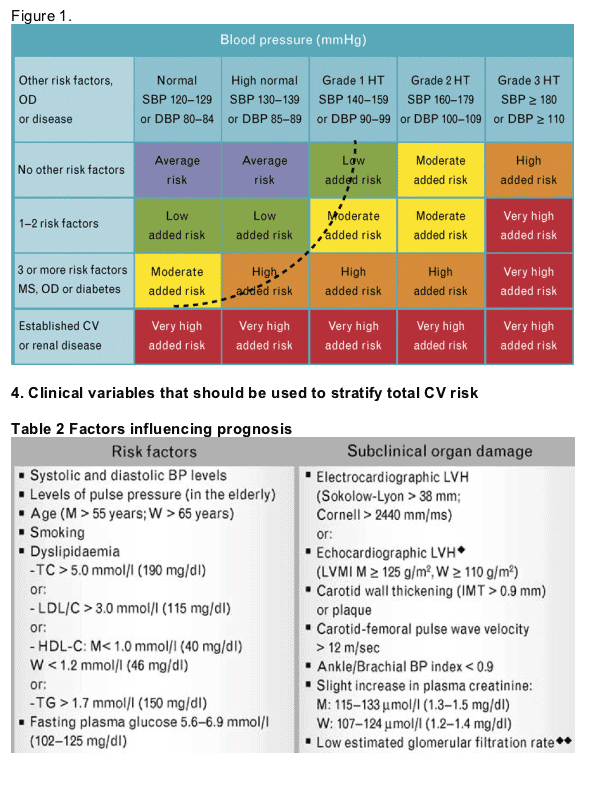
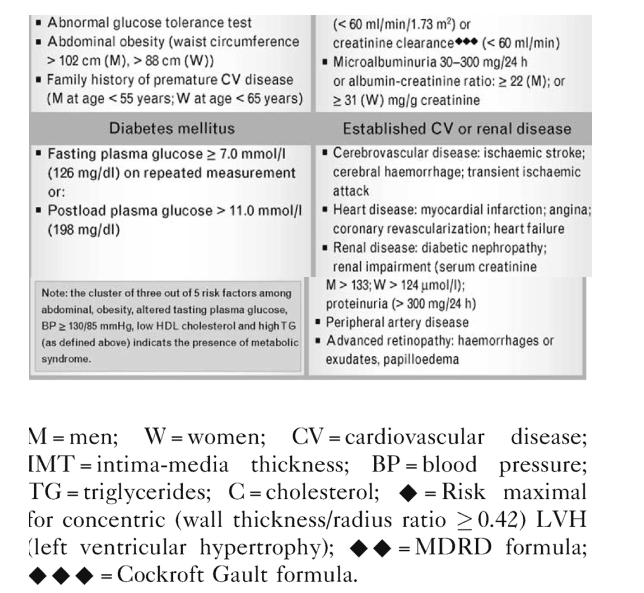
5. Diagnostic evaluation
5.1 Aims
* Establishing BP values
* Identifying secondary causes of hypertension
* Searching for
* other risk factors;
* subclinical organ damage;
* concomitant diseases;
* accompanying CV and renal complications.
5.2 Procedures
* repeated BP measurements
* family and clinical history
* physical examination
* laboratory and instrumental investigations.
6. Blood pressure (BP) measurement
When measuring BP, care should be taken to:
* Allow the patients to sit quietly for several minutes;
* Take at least two measurements spaced by 1-2 minutes;
* Use a standard bladder (12-13 cm long and 35 cm wide) but have a larger bladder available for fat arms and a smaller one for thin arms and children;
* Have the cuff at the level of the heart, whatever the position of the patient;
* Deflate the cuff at a speed of 2 mmHg/s;
* Use phase I and V (disappearance) Korotkoff sounds to identify SBP and DBP, respectively;
* Measure BP in both arms at first visit to detect possible differences due to peripheral vascular disease. In this instance, take the higher value as the reference one;
* Measure BP 1 and 5 min after assumption of the standing position in elderly subjects, diabetic patients, and when postural hypotension may be frequent or suspected;
* Measure heart rate by pulse palpation (at least 30 sec).
7. Ambulatory and home BP measurements
7.1 Ambulatory BP
* Although office BP should be used as the reference, ambulatory BP may improve prediction of CV risk in untreated and treated patients.
* 24-h ambulatory BP monitoring should be considered, in particular, when
- considerable variability of office BP is found
- high office BP is measured in subjects otherwise at low total CV risk
- there is a marked discrepancy between BP values measured in the office and at home
- resistance to drug treatment is suspected
- hypotensive episodes are suspected, particularly in elderly and diabetic patients
- sleep apnoea is suspected
- office BP is elevated in pregnant women and pre-eclampsia is suspected
Normal values for 24 hour average BP are lower than for office BP, i.e. < 125-130 mmHg systolic and < 80 mmHg diastolic. Normal values of daytime BP are < 130-135 mmHg systolic and < 85 mmHg diastolic.
7.2 Home BP
* Self-measurement of BP at home is of clinical value. Home BP measurements should be encouraged in order to:
- provide more information on the BP lowering effect of treatment at trough, and thus on therapeutic coverage throughout the dose-to-dose time interval
- improve patient's adherence to treatment regimens
- understand technical reliability/environmental conditions of ambulatory BP data
* Self-measurement of BP at home should be discouraged whenever:
- it causes anxiety to the patient
- it induces self-modification of the treatment regimen
* Normal values for home BP are lower than for office BP, i.e. < 130-135 mmHg systolic and < 85 mmHg diastolic.
7.3 Particular conditions
Isolated office hypertension (White coat hypertension)
Office BP persistently ≥ 140/90 mmHg
Normal daytime ambulatory (< 130-135/85 mmHg) or home (< 130-135/85 mmHg) BP
In these subjects CV risk is less than in individuals with raised office and ambulatory or home BP but may be slightly greater than that of individuals with in and out-of-office normotension.
Isolated ambulatory hypertension (Masked hypertension)
Office BP persistently normal (< 140/90 mmHg)
Elevated ambulatory (≥ 125-130/80 mmHg) or home (≥ 130-135/85 mmHg) BP
In these subjects CV risk is close to that of individuals with in and out-of-office hypertension
8. Diagnostic evaluation: medical history and physical examination
8.1 Family and clinical history
1. Duration and previous level of high BP
2. Indications of secondary hypertension
3. Risk factors
4. Symptoms of organ damage
5. Previous antihypertensive therapy (efficacy, adverse events)
6. Personal, family, environmental factors.
8.2 Physical examinations
1. Signs suggesting secondary hypertension
2. Signs of organ damage
3. Evidence of visceral obesity.
9. Laboratory investigation
9.1 Routine tests
* Fasting plasma glucose
* Serum total cholesterol
* Serum LDL-cholesterol
* Serum HDL-cholesterol
* Fasting serum triglycerides
* Serum potassium
* Serum uric acid
* Serum creatinine
* Estimated creatinine clearance (Cockroft-Gault formula) or glomerular filtration rate (MDRD formula)
* Haemoglobin and haematocrit
* Urinalysis (complemented by microalbuminuria dipstick test and microscopic examination)
* Electrocardiogram.
9.2 Recommended tests
* Echocardiogram
* Carotid ultrasound
* Quantitative proteinuria (if dipstick test positive)
* Ankle-brachial BP Index
* Fundoscopy
* Glucose tolerance test (if fasting plasma glucose > 5.6 mmol/L (100 mg/dL)
* Home and 24h ambulatory BP monitoring
* Pulse wave velocity measurement (where available).
9.3 Extended evaluation (domain of the specialist)
* Further search for cerebral, cardiac, renal and vascular damage. Mandatory in complicated hypertension.
* Search for secondary hypertension when suggested by history, physical examination or routine tests: measurement of renin, aldosterone, corticosteroids, catecholamines in plasma and/or urine; arteriographies; renal and adrenal ultrasound; computer-assisted tomography; magnetic resonance imaging.
10. Searching for subclinical organ damage
Due to the importance of subclinical organ damage as an intermediate stage in the continuum of vascular disease and as a determinant of total CV risk, signs of organ involvement should be sought carefully by appropriate techniques:
10.1 Heart
Electrocardiography should be part of all routine assessment of subjects with high BP in order to detect left ventricular hypertrophy, patterns of strain, ischaemia and arrhythmias. Echocardiography is recommended when a more sensitive method of detection of left ventricular hypertrophy is considered useful as well as assessment of left ventricular systolic function. Geometric patterns can be defined echocardiographically, of which concentric hypertrophy carries the worse prognosis. Diastolic dysfunction can be evaluated by transmitral Doppler.
10.2 Blood vessels
Ultrasound scanning of the extracranial carotid arteries is recommended when detection of vascular hypertrophy or asymptomatic atherosclerosis is deemed useful. Large artery stiffening (leading to isolated systolic hypertension in the elderly) can be measured by pulse wave velocity. It might be more widely recommended if its availability were greater. A low ankle-brachial BP index signals advanced peripheral artery disease.
10.3 Kidney
Diagnosis of hypertension-related renal damage is based on a reduced renal function or an elevated urinary excretion of albumin. Estimation from serum creatinine of glomerular filtration rate (MDRD formula, requiring age, gender, race) or creatinine clearance (Cockroft-Gault formula, requiring also body weight) should be routine procedure. Urinary protein should be sought in all hypertensives by dipstick. In dipstick negative patients low grade albuminuria (microalbumniuria) should be determined in spot urine and related to urinary creatinine excretion.
10.4 Fundoscopy
Examination of eye grounds is recommended in severe hypertensives only. Mild retinal changes are largely non-specific except in young patients. Haemorrhages, exudates and papilloedema, only present in severe hypertension, are associated with increased CV risk.
10.5 Brain
Silent brain infarcts, lacunar infarctions, microbleeds and white matter lesions are not infrequent among hypertensives, and can be detected by MRI or CT. Availability and costs do not allow indiscriminate use of these techniques. In elderly hypertensives, cognitive tests may help to detect initial brain deterioration.
The Table 3 summarizes availability, prognostic value and cost of procedures to detect subclinical organ damage.
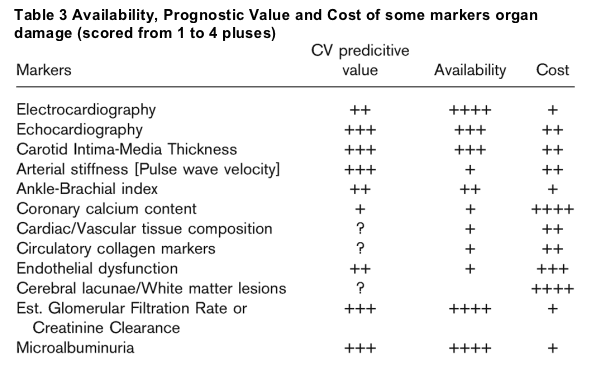
11. Evidence on the benefit of antihypertensive treatment
* Placebo controlled trials have provided uncontroversial evidence that BP lowering reduces fatal and non-fatal cardiovascular events. Beneficial effects have been found when treatment is initiated with a thiazide diuretic, a β-blocker, a calcium antagonist, an ACE-inhibitor or an angiotensin receptor blocker.
* Trials comparing different antihypertensive drugs have not been able to conclusively demonstrate that for the same reduction in BP different antihypertensive drugs (or drug combinations) reduce to different degree CV events. These trials (and their meta-analysis and meta-regressions) underline the crucial role of BP lowering in reducing all kinds of CV events, i.e. stroke, myocardial infarction and heart failure, independently of the agents used.
* BP-independent effects related to use of specific drugs have been reported for cause-specific events, e.g. stroke, heart failure and coronary events, but these effects are smaller than the dominant effect of BP lowering
* BP-independent effects attributable to specific drugs have been more consistently shown for events that occur earlier in the continuum of CV disease, e.g. protection against subclinical organ damage and prevention of high risk conditions such as diabetes, renal failure and atrial fibrillation.
12. Initiation of BP lowering therapy
* Initiation of BP lowering therapy should be decided on two criteria:
1. The level of SBP and DBP
2. The level of total CV risk
* This is detailed in the Figure 2 which considers treatment based on lifestyle changes and antihypertensive drugs with, in addition, recommendations on the time delay to be used for assessing the BP lowering effects.
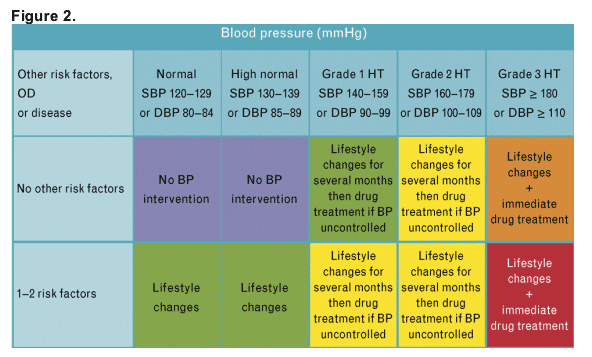
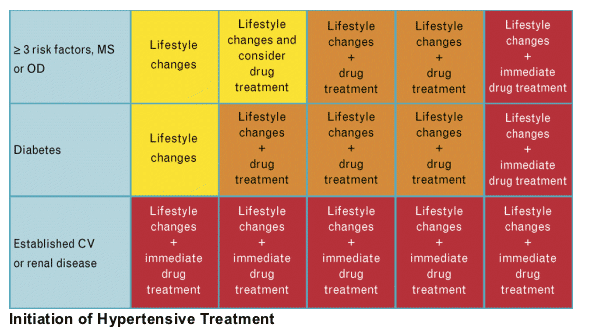
The following points should be emphasized:
* Drug treatment should be initiated promptly in grade 3 hypertension as well as in grade 1 and 2 when total CV risk is high or very high.
* In grade 1 or 2 hypertensives with moderate total CV risk drug treatment may be delayed for several weeks and in grade 1 hypertensives without any other risk factor for several months. However, even in these patients lack of BP control after a suitable period should lead to initiation of drug treatment.
* When initial BP is in the high normal range the decision on drug intervention heavily depends on the level of risk. In the case of diabetes, history of cerebrovascular, coronary or peripheral artery disease, the recommendation to start BP lowering drugs is justified by the results of controlled trials. Subjects with BP in the high normal range in whom total CV risk is high because of a subclinical organ damage should be advised to implement intense lifestyle measures. In these subjects BP should be closely monitored and drug treatment considered in the presence of a worsening of the clinical condition.
13. Goals of treatment
* In hypertensive patients, the primary goal of treatment is to achieve maximum reduction in the long-term total risk of CV disease.
* This requires treatment of the raised BP per se as well as of all associated reversible risk factors.
* BP should be reduced to at least below 140/90 mmHg (systolic/diastolic), and to lower values, if tolerated, in all hypertensive patients.
* Target BP should be at least < 130/80 mmHg in patients with diabetes and in high or very high risk patients, such as those with associated clinical conditions (stroke, myocardial infarction, renal dysfunction, proteinuria).
* Despite use of combination treatment, reducing systolic BP to < 140 mmHg may be difficult and more so if the target is a reduction to < 130 mmHg. Additional difficulties should be expected in the elderly, in patients with diabetes, and in general, in patients with CV damage.
* In order to more easily achieve goal BP, antihypertensive treatment should be initiated before significant CV damage develops.
14. Lifestyle changes
* Lifestyle measures should be instituted, whenever appropriate, in all patients, including those who require drug treatment. The purpose is to lower BP, to control other risk factors and to reduce the number or the doses of antihypertensive drugs.
* Lifestyle measures are also advisable in subjects with high normal BP and additional risk factors to reduce the risk of developing hypertension.
* The lifestyle measures that are widely recognized to lower BP and/or CV risk, and that should be considered are:
- smoking cessation
- weight reduction (and weight stabilization)
- reduction of excessive alcohol intake
- physical exercise
- reduction of salt intake
- increase in fruit and vegetable intake and decrease in saturated and total
- fat intake
* Lifestyle recommendations should not be given as lip service but instituted with adequate behavioural and expert support, and reinforced periodically.
* Because long-term compliance with lifestyle measures is low and the BP response highly variable, patients under non-pharmacological treatment should be followed-up closely to start drug treatment when needed and in a timely fashion.
15. Choice of antihypertensive drugs
* The main benefits of antihypertensive therapy are due to lowering of BP per se
* Five major classes of antihypertensive agents - thiazide diuretics, calcium antagonists, ACE-inhibitors, angiotensin receptor blockers and β-blockers - are suitable for the initiation and maintenance of antihypertensive treatment, alone or in combination. β-blockers, especially in combination with a thiazide diuretic, should not be used in patients with the metabolic syndrome or at high risk of incident diabetes.
* In many patients more than one drug is needed, so emphasis on identification of the first class of drugs to be used is often futile. Nevertheless, there are conditions for which there is evidence in favour of some drugs versus others either as initial treatment or as part of a combination.
* The choice of a specific drug or a drug combination, and the avoidance of others should take into account the following:
1. The previous favourable or unfavourable experience of the individual patient with a given class of compounds.
2. The effect of drugs on CV risk factors in relation to the CV risk profile of the individual patient.
3. The presence of subclinical organ damage, clinical CV disease, renal disease or diabetes, which may be more favourably treated by some drugs than others.
4. The presence of other disorders that may limit the use of particular classes of antihypertensive drugs.
5. The possibilities of interactions with drugs used for other conditions.
6. The cost of drugs, either to the individual patient or to the health provider. However, cost considerations should never predominate over efficacy, tolerability, and protection of the individual patient.
* Continuing attention should be given to side-effects of drugs, because they are the most important cause of non-compliance. Drugs are not equal in terms of adverse effects, particularly in individual patients.
* The BP lowering effect should last 24 hours. This can be checked by office or home BP measurements at trough or by ambulatory BP monitoring.
* Drugs which exert their antihypertensive effect over 24 hours with a once-a-day administration should be preferred because a simple treatment schedule favours compliance.
16. Conditions favouring the use of some antihypertensive drugs versus other
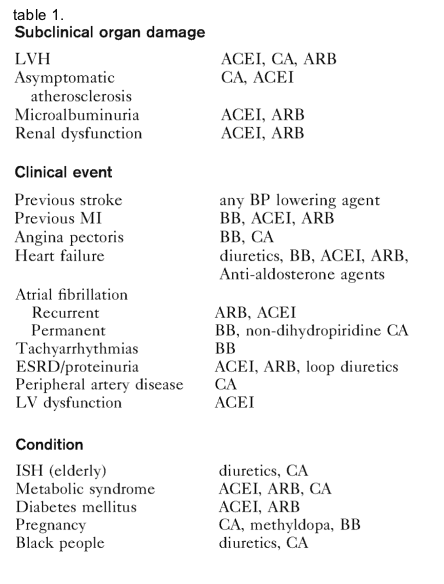
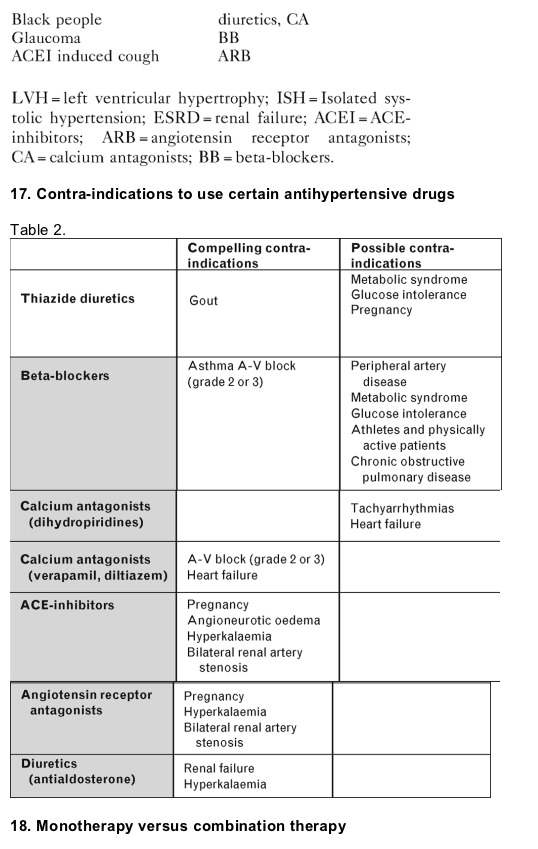
* Regardless of the drug employed, monotherapy allows to achieve BP target in only a limited number of hypertensive patients.
* Use of more than one agent is necessary to achieve target BP in the majority of patients. A vast array of effective and well tolerated combinations is available.
* Initial treatment can make use of monotherapy or combination of two drugs at low doses with a subsequent increase in drug doses or number, if needed.
* Monotherapy could be the initial treatment for mild BP elevation with low or moderate total CV risk. A combination of two drugs at low doses should be preferred as the first step in treatment when the initial BP is in the grade 2 or 3 or total CV risk is high or very high with mild BP elevation.
* Fixed combinations of two drugs can simplify the treatment schedule and favour compliance.
* In several patients BP control is not achieved by two drugs, and a combination of three of more drugs is required.
* In uncomplicated hypertensives and in the elderly, antihypertensive therapy should normally be initiated gradually. In higher risk hypertensives, goal BP should be achieved more promptly, which favours initial combination therapy and quicker adjustment of doses.
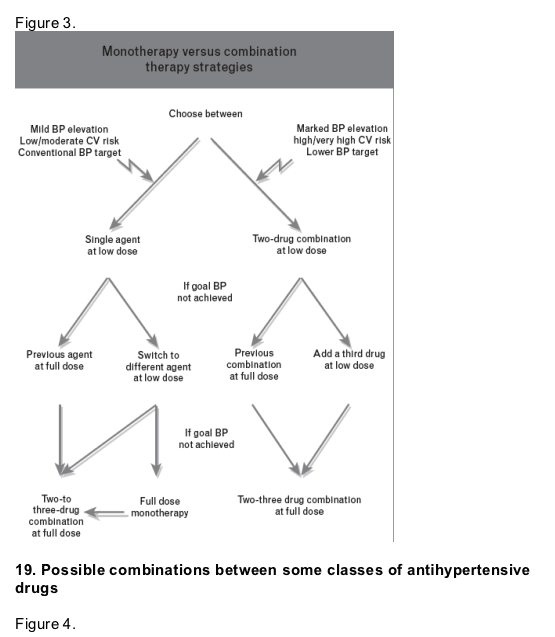
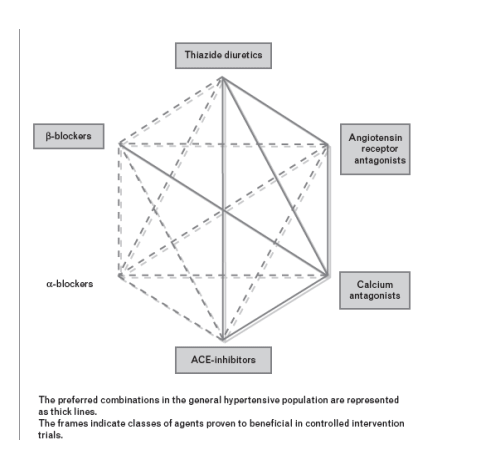
20. Antihypertensive treatment in special groups
Antihypertensive treatment may differ from the one recommended in the general hypertensive population, in special groups of patients or in specific clinical conditions. The specific requirements under these circumstances are detailed below.
20.1 Elderly patients
* Drug treatment can be initiated with thiazide diuretics, calcium antagonists, angiotensin receptor antagonists, ACE-inhibitors, and β-blockers, in line with general guidelines. Trials specifically addressing treatment of isolated systolic hypertension have shown the benefit of thiazides and calcium antagonists but subanalysis of other trials also show efficacy of angiotensin receptor blockers.
* Initial doses and subsequent dose titration should be more gradual because of a greater chance of undesirable effects, especially in very old and frail subjects.
* BP goal is the same as in younger patients, i.e. < 140/90 mmHg or below, if tolerated. Many elderly patients need two or more drugs to control blood pressure and reductions to < 140 mmHg systolic may be difficult to obtain.
* Drug treatment should be tailored to the risk factors, target organ damage and associated cardiovascular and non-cardiovascular conditions that are frequent in the elderly. Because of the increased risk of postural hypotension, BP should always be measured also in the erect posture.
* In subjects aged 80 years and over, evidence for benefits of antihypertensive treatment is as yet inconclusive. However, there is no reason for interrupting a successful and well tolerated therapy when a patient reaches 80 years of age.
20.2 Diabetic patients
* Where applicable, intense non-pharmacological measures should be encouraged in all patients with diabetes, with particular attention to weight loss and reduction of salt intake in type 2 diabetes.
* Goal BP should be < 130/80 mmHg and antihypertensive drug treatment may be started already when BP is in the high normal range.
* To lower BP, all effective and well tolerated drugs can be used. A combination of two or more drugs is frequently needed.
* Available evidence indicates that lowering BP also exerts a protective effect on appearance and progression of renal damage. Some additional protection can be obtained by the use of a blocker of the renin-angiotensin system (either an angiotensin receptor antagonist or an ACE-inhibitor).
* A blocker of the renin-angiotensin system should be a regular component of combination treatment and the one preferred when monotherapy is sufficient.
* Microalbuminuria should prompt the use of antihypertensive drug treatment also when initial BP is in the high normal range. Blockers of the renin-angiotensin system have a pronounced antiproteinuric effect and their use should be preferred.
* Treatment strategies should consider an intervention against all CV risk factors, including a statin.
* Because of the greater chance of postural hypotension, BP should also be measured in the erect posture.
20.3 Patients with renal dysfunction
* Renal dysfunction and failure are associated with a very high risk of CV events.
* Protection against progression of renal dysfunction has two main requirements: a) strict blood pressure control (< 130/80 mmHg and even lower if proteinuria is > 1g/day); b) lowering proteinuria to values as near to normal as possible.
* To achieve the BP goal, combination therapy of several antihypertensive agents (including loop diuretics) is usually required.
* To reduce proteinuria, an angiotensin receptor antagonist, an ACE-inhibitor or a combination of both are required.
* There is controversial evidence as to whether blockade of the renin-angiotensin system has a specific beneficial role in preventing or retarding nephrosclerosis in non-diabetic non-proteinuric hypertensives, except perhaps in Afro-American individuals. However, inclusion of one of these agents in the combination therapy required by these patients appears well founded.
* An integrated therapeutic intervention (antihypertensive, statin and antiplatelet therapy) has to be frequently considered in patients with renal damage because, under these circumstances, CV risk is extremely high.
20.4 Patients with cerebrovascular disease
* In patients with a history of stroke or transient ischaemic attacks, antihypertensive treatment markedly reduces the incidence of stroke recurrence and also lowers the associated high risk of cardiac events.
* Antihypertensive treatment is beneficial in hypertensive patients as well as in subjects with BP in the high normal range. BP goal should be < 130/80 mmHg.
* Because evidence from trials suggests that the benefit largely depends on BP lowering per se, all available drugs and rational combinations can be used. Trial data have been mostly obtained with ACE-inhibitors and angiotensin receptor antagonists, in association with or on the top of diuretic and conventional treatment, but more evidence is needed before their specific cerebrovascular protective properties are established.
* There is at present no evidence that BP lowering has a beneficial effect in acute stroke but more research is under way. Until more evidence is obtained antihypertensive treatment should start when post-stroke clinical conditions are stable, usually several days after the event. Additional research in this is necessary because cognitive dysfunction is present in about 15% and dementia in 5% of subjects aged ≥ 65 years.
* In observational studies, cognitive decline and incidence of dementia have a positive relationship with BP values. There is some evidence that both can be somewhat delayed by antihypertensive treatment.
20.5 Patients with coronary heart disease and heart failure
* In patients surviving a myocardial infarction, early administration of β-blockers, ACE-inhibitors or angiotensin receptor blockers reduces the incidence of recurrent myocardial infarction and death. These beneficial effects can be ascribed to the specific protective properties of these drugs but possibly also to the associated small BP reduction.
* Antihypertensive treatment is also beneficial in hypertensive patients with chronic coronary heart disease. The benefit can be obtained with different drugs and drug combinations (including calcium antagonists) and appears to be related to the degree of BP reduction. A beneficial effect has been demonstrated also when initial BP is < 140/90 mmHg and for achieved BP around 130/80 mmHg or less.
* A history of hypertension is common while a raised BP is relatively rare in patients with congestive heart failure. In these patients, treatment can make use of thiazide and loop diuretics, as well as of β-blockers, ACE-inhibitors, angiotensin receptor antagonist and antialdosterone drugs on top of diuretics. Calcium antagonists should be avoided unless needed to control BP or anginal symptoms.
* Diastolic heart failure is common in patients with a history of hypertension and has an adverse prognosis. There is at present no evidence on the superiority of specific antihypertensive drugs.
20.6 Patients with atrial fibrillation
* Hypertension is the most important risk factor for atrial fibrillation. Atrial fibrillation markedly increases the risk of CV morbidity and mortality, particularly of embolic stroke.
* Increased left ventricular mass and left atrium enlargement are independent determinants of atrial fibrillation, and require intense antihypertensive therapy.
* Strict blood pressure control is required in patients under anticoagulant treatment to avoid intracerebral and extracerebral bleeding.
* Less new onset and recurrent atrial fibrillation has been reported in hypertensive patients treated with angiotensin receptor antagonists.
* In permanent atrial fibrillation, β-blockers and non-dihydropyridine calcium antagonists (verapamil, diltiazem) help controlling ventricular rate.
21. Hypertension in women
21.1 Treatment
Response to antihypertensive agents and beneficial effects of BP lowering appear to be similar in women and in men. However, ACE-inhibitors and angiotensin receptor antagonists should be avoided in pregnant and women planning pregnancy because of potential teratogenic effects during pregnancy.
21.2 Oral contraceptives
Even oral contraceptives with low oestrogen content are associated with an increased risk of hypertension, stroke and myocardial infarction. The progestogen-only pill is a contraceptive option for women with high BP, but their influence on cardiovascular outcomes has been insufficiently investigated.
21.3 Hormone replacement therapy
The only benefit of this therapy is a decreased incidence of bone fractures and colon cancer, accompanied, however, by increased risk of coronary events, stroke, thromboembolism, breast cancer, gallbladder disease and dementia. This therapy is not recommended for cardioprotection in postmenopausal women.
21.4 Hypertension in pregnancy
* Hypertensive disorders in pregnancy, particularly pre-eclampsia, may adversely affect neonatal and maternal outcomes.
* Non-pharmacological management (including close supervision and restriction of activities) should be considered for pregnant women with SBP 140-149 mmHg or DBP 90-95 mmHg. In the presence of gestational hypertension (with or without proteinuria) drug treatment is indicated at BP levels > 140/90 mmHg. SBP levels ≥ 170 or DBP ≥ 110 mmHg should be considered an emergency requiring hospitalization.
* In non-severe hypertension, oral methyldopa, labetalol, calcium antagonists and (less frequently) β-blockers are drugs of choice.
* In pre-eclampsia with pulmonary oedema, nitroglycerine is the drug of choice. Diuretic therapy is inappropriate because plasma volume is reduced.
* As emergency, intravenous labetalol, oral methyldopa and oral nifedipine are indicated. Intravenous hydralazine is no longer the drug of choice because of an excess of perinatal adverse effects. Intravenous infusion of sodium nitroprusside is useful in hypertensive crises, but prolonged administration should be avoided.
* Calcium supplementation, fish oil and low dose aspirin are not recommended. However, low dose aspirin may be used prophylactically in women with a history of early onset pre-eclampsia.
22. The metabolic syndrome
* The metabolic syndrome is characterized by the variable combination of visceral obesity and alterations in glucose metabolism, lipid metabolism and BP. It has a high prevalence in the middle age and elderly population.
* Subjects with the metabolic syndrome also have a higher prevalence of microalbuminuria, left ventricular hypertrophy and arterial stiffness than those without metabolic syndrome. Their CV risk is high and the chance of developing diabetes markedly increased.
* In patients with metabolic syndrome diagnostic procedures should include a more in-depth assessment of subclinical organ damage. Measuring ambulatory and home BP is also desirable.
* In all individuals with metabolic syndrome intense lifestyle measures should be adopted. When there is hypertension drug treatment should start with a drug unlikely to facilitate onset to diabetes. Therefore a blocker of the renin-angiotensin system should be used and followed, if needed, by the addition of a calcium antagonist or a low-dose thiazide diuretic. It appears desirable to bring BP to the normal range.
* Lack of evidence from specific clinical trials prevents firm recommendations on use of antihypertensive drugs in all metabolic syndrome subjects with a high normal BP. There is some evidence that blocking the renin-angiotensin system may also delay incident hypertension.
* Statins and antidiabetic drugs should be given in the presence of dyslipidemia and diabetes, respectively. Insulin sensitizers have been shown to markedly reduce new onset diabetes, but their advantages and disadvantages in the presence of impaired fasting glucose or glucose intolerance as a metabolic syndrome component remain to be demonstrated.
23. Resistant hypertension
23.1 Definition
BP ≥ 140/90 mmHg despite treatment with at least three drugs (including a diuretic) in adequate doses and after exclusion of spurious hypertension such as isolated office hypertension and failure to use large cuffs on large arms.
23.2 Causes
* Poor adherence to therapeutic plan;
* Failure to modify lifestyle including:
weight gain
heavy alcohol intake (NB: binge drinking);
* Continued intake of drugs that raise blood pressure (liquorice, cocaine, glucocorticoids, non-steroid anti-inflammatory drugs, etc.);
* Obstructive sleep apnea;
* Unsuspected secondary cause;
* Irreversible or limited reversibility of organ damage;
* Volume overload due to:
inadequate diuretic therapy
progressive renal insufficiency
high sodium intake
hyperaldosteronism.
23.3 Treatment
* Adequate investigation of causes
* If necessary, use of more than three drugs, including an aldosterone
* antagonist.
24. Hypertensive emergencies
* Hypertensive encephalopathy
* Hypertensive left ventricular failure
* Hypertension with myocardial infarction
* Hypertension with unstable angina
* Hypertension and dissection of the aorta
* Severe hypertension associated with subarachnoid haemorrhage or cerebrovascular accident
* Crisis associated with phaeochromocytoma
* Use of recreational drugs such as amphetamines, LSD, cocaine or ecstasy
* Hypertension perioperatively
* Severe pre-eclampsia or eclampsia
25. Treatment of associated risk factors
25.1 Lipid lowering agents
* All hypertensive patients with established CV disease or with type 2 diabetes should be considered for statin therapy aiming at serum total and LDL cholesterol levels of, respectively, < 4.5 mmol/L (175 mg/dL) and < 2.5 mmol/L (100 mg/dL), and lower, if possible.
* Hypertensive patients without overt CV disease but with high CV risk (≥ 20% risk of events in 10 years) should also be considered for statin treatment even if their baseline total and LDL serum cholesterol levels are not elevated.
25.2 Antiplatelet therapy
* Antiplatelet therapy, in particular low-dose aspirin, should be prescribed to hypertensive patients with previous CV events, provided that there is no excessive risk of bleeding.
* Low-dose aspirin should also be considered in hypertensive patients without a history of CV disease if older than 50 years and with a moderate increase in serum creatinine or with a high CV risk. In all these conditions, the benefit-to-risk ratio of this intervention (reduction in myocardial infarction greater than the risk of bleeding) has been proven favourable.
* To minimize the risk of haemorrhagic stroke, antiplatelet treatment should be started after achievement of BP control.
25.3 Glycaemic control
* Effective glycaemic control is of great importance in patients with hypertension and diabetes.
* In these patients dietary and drug treatment of diabetes should aim at lowering plasma fasting glucose to values 6 mmol/L (108 mg/dL) and at a glycated haemoglobin of < 6.5%.
26. Patients' follow-up
* Effective and timely titration to BP control requires frequent visits in order to timely modify the treatment regimen in relation to BP changes and the appearance of side-effects.
* Once the target BP has been reached, the frequency of visits can be considerably reduced. However, excessively wide intervals between visits are not advisable because they interfere with a good doctor-patient relationship, which is crucial for patient's compliance.
* Patients at low risk or with grade 1 hypertension may be seen every 6 months and regular home BP measurements may further extend this interval. Visits should be more frequent in high or very high risk patients. This is the case also in patients under non-pharmacological treatment alone due to the variable antihypertensive response and the low compliance to this intervention.
* Follow-up visits should aim at maintaining control of all reversible risk factors as well as at checking the status of organ damage. Because treatment-induced changes in left ventricular mass and carotid artery wall thickness are slow, there is no reason to perform these examinations at less than 1 year intervals.
* Treatment of hypertension should be continued for life because in correctly diagnosed patients cessation of treatment is usually followed by return to the hypertensive state. Cautious downward titration of the existing treatment may be attempted in low risk patients after long-term BP control, particularly if non-pharmacological treatment can be successfully implemented.
27. How to improve compliance with blood pressure lowering therapy
* Inform the patient of the risk of hypertension and the benefit of effective treatment.
* Provide clear written and oral instructions about treatment.
* Tailor the treatment regimen to patient's lifestyle and needs.
* Simplify treatment by reducing, if possible, the number of daily medicaments.
* Involve the patient's partner or family in information on disease and treatment plans.
* Make use of self measurement of BP at home and of behavioural strategies such as reminder systems.
* Pay great attention to side-effects (even if subtle) and be prepared to timely change drug doses or types, if needed.
* Dialogue with patient regarding adherence and be informed of his/her problems.
* Provide reliable support system and affordable prices.
* Arrange a schedule of follow-up visits.
Disclaimer: The ESH Guidelines represent the views of the ESH and were arrived at after careful consideration of the available evidence at the time they were written. Health professionals are encouraged to take them fully into account when exercising their clinical judgment. The guidelines do not, however, override the individual responsibility of health professionals to make appropriate decisions in the circumstances of the individual patients, in consultation with that patient, and where appropriate and necessary the patient's guardian or carer. It is also the health professional's responsibility to verify the rules and regulations applicable to drugs and devices at the time of prescription.
|
|
| |
| |
|
|
|